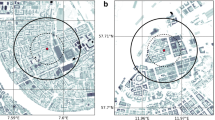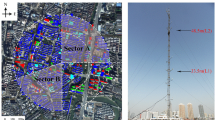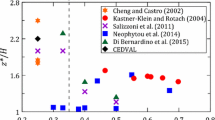Abstract
The possibility of obtaining urban roughness length from satellite-derived maps of land cover is explored, using turbulence measurements taken above the urban canopy. The upwind land cover is identified using a source-area model. Firstly, from four sets of measurements taken in Birmingham (U.K.), it is shown that in an area mainly split between the land-cover types ‘urban’ and ‘suburban’, suburban cover in the upwind source area is the more important contributor to increasing measured roughness length. A smaller dataset obtained in a second U.K. city (Salford, Greater Manchester) shows a similar result. A roughness-length aggregation model is also applied to the data from both sites. This assigns values of roughness length to each of the land-cover classifications and uses the source-area model to predict the resultant roughness length based on the wind properties. The results from this are shown to agree with the earlier findings.
Similar content being viewed by others
References
S. P. Arya (1988) Introduction to Micrometeorology Academic Press San Diego
J. Cihlar (2000) ArticleTitle‘Land Cover Mapping of Large Areas from Satellites: Status and Research Priorities’ Int J. Remote Sensing 21 1093–1114
R. M. Fuller G. B. Groom A. R. Jones (1994) ArticleTitle‘The Land Cover Map of Great Britain: An Automated Classification of Landsat Thematic Mapper Data’, Photogram Eng. Remote Sensing 60 553–562
C.S.B. Grimmond T.R. Oke (1999) ArticleTitle‘Aerodynamic Properties of Urban Areas Derived from Analysis of Surface Form’ J. Appl. Meteorol 38 1262–1292
C.B. Hasager N.O. Jensen (1999) ArticleTitle‘Surface-flux Aggregation in Heterogeneous Terrain’ Quart. J. Roy. Meteorol. Soc 125 2075–2102
R.W. Macdonald R.F. Griffiths D.J. Hall (1998) ArticleTitle‘An Improved Method for the Estimation of Surface Roughness of Obstacle Arrays’ Atmos. Environ 32 1857–1864
P.J. Mason (1988) ArticleTitle‘The Formation of Areally Averaged Roughness Lengths’ Quart. J. Roy. Meteorol. Soc 114 399–420
G.G. Rooney (2001) ArticleTitle‘Comparison of Upwind Land Use and Roughness Length Measured in the Urban Boundary Layer’ Boundary-Layer Meteorol 100 469–486
H.P. Schmid (1994) ArticleTitle‘Source Areas for Scalars and Scalar Fluxes’ Boundary-Layer Meteorol 67 293–318
H.P. Schmid (1997) ArticleTitle‘Experimental Design for Flux Measurements: Matching Scales of Observation and Fluxes’ Agric. For. Meteorol 87 179–200
H.P. Schmid T.R. Oke (1990) ArticleTitle’A Model to Estimate the Source Area Contributing to Turbulent Exchange in the Surface Layer over Patchy Terrain’ Quart. J. Roy. Meteorol. Soc 116 965–988
J. Wieringa (1993) ArticleTitle‘Representative Roughness Parameters for Homogeneous Terrain’ Boundary-Layer Meteorol 63 323–363
Author information
Authors and Affiliations
Corresponding author
Additional information
The British Crown’s right to retain a non-exclusive royalty-free license in and to any copyright is acknowledged
Rights and permissions
About this article
Cite this article
Rooney, G.G., Longley, I.D. & Barlow, J.F. Variation Of Urban Momentum Roughness Length With Land Use In The Upwind Source Area, As Observed in Two U.K. Cities. Boundary-Layer Meteorol 115, 69–84 (2005). https://doi.org/10.1007/s10546-004-2987-x
Received:
Issue Date:
DOI: https://doi.org/10.1007/s10546-004-2987-x




